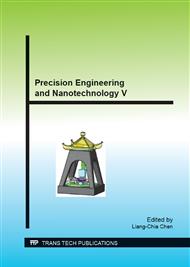p.201
p.207
p.213
p.219
p.224
p.230
p.234
p.241
p.247
Optimal Design of Piezoelectric Actuator for Precision Positioning Applications
Abstract:
Recent advances in measurement systems require positioning systems with high stiffness, accuracy and speed. Piezoelectric actuators which are featured with mechanical simplicity, quick response, and electromagnetic immunity, are often used in precision positioning. It is known that piezoelectric actuators can achieve high positioning accuracy by the stepping mode but low speed. By contrast, the resonance vibration mode will offer high positioning speed, but sacrifices the high inherent position resolution. For the stepping mode, the displacement of the piezoelectric actuator significantly affects the speed, of which larger displacement induces higher speed. For the resonance vibration mode, an elliptical motion of the piezoelectric actuator tip is generated by horizontal and vertical eigenmodes, and the optimal efficiency can be achieved when the two eigenmodes are operated at the same frequency. For the applications of high positioning accuracy and speed, a piezoelectric actuator should be designed by taking these two operation modes into consideration simultaneously. Based on these requirements, the optimal structural dimensions of a piezoelectric actuator are obtained using a genetic algorithm.
Info:
Periodical:
Pages:
224-229
Citation:
Online since:
August 2014
Authors:
Price:
Сopyright:
© 2015 Trans Tech Publications Ltd. All Rights Reserved
Share:
Citation:


